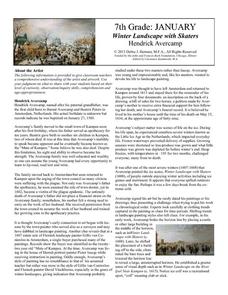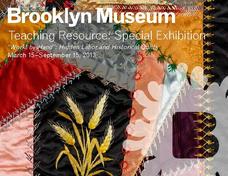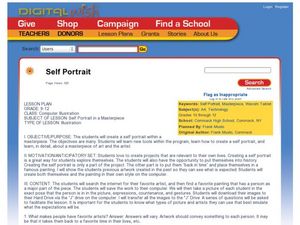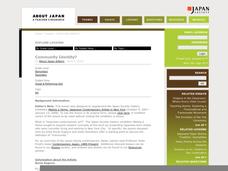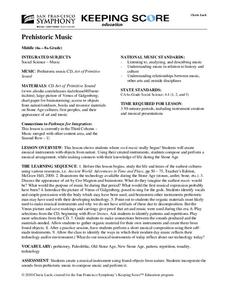Concordia University Chicago
Winter Landscape with Skaters by Hendrick Avercamp
In need of a quick set of ideas to use on a wintery day? Why not analyze Winter Landscape with Skaters with your class? After a thorough discussion, learners compare and contrast two paintings, research what curators do, draw landscapes,...
Concordia University Chicago
Peace and Plenty by George Inness
Learners will need to discuss the Civil War to truly understand the painting Peace and Plenty by George Inness. They'll analyze the painting in terms of context, style, and technique. Then, they'll experiment with light and composition...
Concordia University Chicago
Tahitian Landscape by Paul Gauguin
Get ready to explore the piece Tahitian Landscape with your seventh graders. They discuss the primitive style, bright colors, and impressionism found in the work, as well as biographical information regarding Gauguin's life. There are...
Sargent Art
Rainsticks
This rainstick lesson isn't just about making art; it's about understanding Native American symbols and culture. Kids read about the use of rainsticks and why specific symbols were used to decorate them. They then make their own...
AMCO
Whimsical Figures
Clay is a wonderful and expressive medium for learners of any age. Kids get creative as they make whimsical figures out of clay. A hyperlinked materials list, images of each step in the process, and helpful tips makes this a great art...
Bright Hub Education
Diego Rivera Murals
Explore Mexican culture and art history through active participation in research and painting. The class discusses and researches the life and art of Diego Rivera, then they paint wonderful murals inspired by his representations of...
Endangered Species Coalition
Endangered Species Day Art
Albrecht Durer created a highly textured stamp or print of a rhinoceros. To better understand which animals are near extinction, upper graders create similar prints of endangered animals they've researched. The six-day lesson includes...
John F. Kennedy Center
Folktale Theatre
Introduce your middle schoolers to a performance and movement activity that uses their favorite stories from fairytales and folklore. They practice basic acting skills, create dialogues with a partner, and then as guided practice,...
Brooklyn Museum
"Workt by Hand": Hidden Labor and Historical Quilts
Just like a painting or the symbols on a flag, quilts can express ideas that reflect a cultural context, space, and time. The class discusses the history of quilt making throughout US history and what different types of quilts mean. They...
Denver Art Museum
Lesson: High Prestige and Status
Prestige and status have been symbolized in many different ways throughout human history. Young art historians analyze an ancient Panamanian medallion for symbols of prestige and status, and then generate a list of other symbols of...
San Francisco Symphony
Ballads for Americans
"Ballad for Americans" was a song written for performers participating in the Federal Arts Project, during The Depression. Learners will analyze the lyrics of the song and then create informational posters about other Federal Works...
National Mississippi River Museum & Aquarium
Sun Printing
Ozalid acid paper is sensitive to the light. It reacts by getting darker, and it's the same paper photographers use when they print their pictures. Here, kids get to use photo-sensitive paper to create sun prints to find out how useful...
Denver Art Museum
Lesson Plan: Symbols & Community
Sand mandalas are transitory art forms that are created by a group for the purpose of healing. Upper graders learn how Tibetan monks create these amazing works of art, and study symbolism and metaphor. Then pupils work together in a...
Denver Art Museum
Lesson: What are Words For?
Words are everywhere in our lives, and our culture shapes how we understand them. Examine the use of words and their impact on society by first examining a word-inspired art piece, and then by creating a thoughtful word-inspired collage....
Denver Art Museum
Lesson Plan: Stories of Home on My Home
Learners research the Lakota tribes, culture, art, and family life. They analyze an installation piece created by a Lakota Indian, and connect what they see to the concept of home. They engage in a discussion, creative writing activity,...
Curated OER
Lesson: Wish You Were Here...
The painting Arcadia features a lovely landscape depicting aspects of ancient Greek life. Little ones use their imagination to put themselves in the painting. After analyzing the details and artistic elements of the painting, they write...
Denver Art Museum
Lesson: That's Not Natural
Any time kids engage in a design project, they are building problem-solving skills, collaborative learning skills, and creative thinking skills. Upper graders take a nature walk to observe and sketch organic shapes and lines that they...
Denver Art Museum
Communicating with Symbols
Before kids analyze a Chinese dish filled with amazing images, they research the meanings of various plant and animal symbols. They use their research to decode the meaning of the expressive artwork on the dish and then use symbolism to...
Digital Wish
Illustration: Self Portrait in a Masterpiece
Technology and art combine in a creative lesson. Kids discuss portrait art and they search online and save a portrait created by one of their favorite artists. They have their picture taken exactly like their chosen portrait, then use...
Asian Art Museum
Community Identity?
To better understand the contemporary arts movement in Japan, learners engage in a guided discussion. They view several photograms by the artist Kunie Sugirua, then discuss the elements of art and techniques used to create each piece....
San Francisco Symphony
Music Reflects History
Exploring the baroque era can be exciting and fun when it's done thorugh the arts. Middle schoolers examine the music and art history of the baroque era through research. They use their findings and class notes to create an expository...
San Francisco Symphony
Prehistoric Music
What was music like during the Stone Age? Learners listen to a CD entitled, Art of Primitive Sound as they consider the culture of people in the Stone Age. They use objects found in nature to create instruments, and then perform a...
San Francisco Symphony
Admirable Armonica Admirers
What do Ben Franklin and Wolfgang Mozart have in common? Find out about the musical invention, the armonica or glassy-chord. Learners will read about how Ben Franklin invented this new instrument and how Wolfgang Mozart came to play it....
San Francisco Symphony
American Civil War Songs
Learners will compare and contrast two songs from the Civil War era, one from the North and one from the South. They'll write a comparative essay on their songs, and then compare their essays and songs with others in their small groups....


